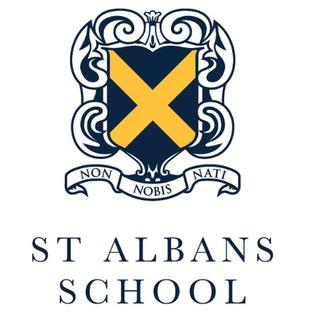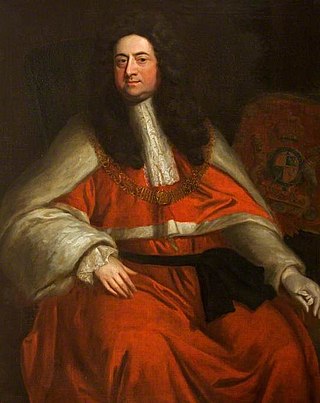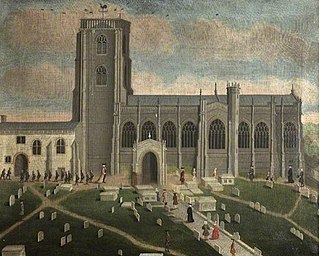History
The school was founded in 1546 by the Corporation of Salisbury, as the result of the Bishop of Salisbury moving the Chancellor's Grammar School into the Cathedral Close. Parliament was given erroneous information about the situation in Bradford on Avon and Trowbridge, and Salisbury obtained funds from the grammar schools in those towns, which closed. [1] With the authority of Queen Elizabeth I, the school was endowed with an income of £26 1s. 8d. a year, paid to the schoolmaster by the Exchequer, through the Mayor of Salisbury. The Mayor and Corporation of the city were Patrons of the school. [2] The attendance at the school of Simon Forman [2] means that it was in operation by 1561. [3]
The school's early home was in George Street, Salisbury. In 1608, it was at the George Inn, but in 1624 it moved into its own premises in Castle Street. [1]
By the early 19th century, the Master's income had been supplemented by the Lectureship of St Thomas, worth £25 a year, founded by the Eyers family. [2]
In 1818, Nicholas Carlisle reported that the school was open to boys of the city on the recommendation of the Mayor, without any limitation of numbers, although at that time there were rarely more than three on the foundation. The school was also open to other boys, and there was no fixed age of entry or leaving. There was only one schoolmaster, the Rev. Charles H. Hodgson, who took in boarders at £40 a year. He used the Eton system of education, with Greek and Latin grammars. [2] [4]
In 1855, there were only seven boys in the school, and the master was only visiting it once or twice a week. He resigned in 1864, when there were only three boys remaining, and the school was closed in 1865. [1]

Salisbury is a cathedral city and civil parish in Wiltshire, England with a population of 41,820, at the confluence of the rivers Avon, Nadder and Bourne. The city is approximately 20 miles from Southampton and 30 miles from Bath.

Sir John Deane's Sixth Form College is a sixth form college in Northwich, Cheshire, UK. It was formerly Sir John Deane's Grammar School, which was founded in 1557.

Bishop Wordsworth's School is a Church of England boys' grammar school in Salisbury, Wiltshire for boys aged 11 to 18. The school is regularly amongst the top-performing schools in England, and in 2010 was the school with the best results in the English Baccalaureate. It was granted academy status in March 2011 and is an Additional Member of the Headmasters' and Headmistresses' Conference. It is within the grounds of Salisbury Cathedral, adjacent to the Cathedral School.

Simon Forman was an Elizabethan astrologer, occultist and herbalist active in London during the reigns of Queen Elizabeth I and James I of England. His reputation, however, was severely tarnished after his death when he was implicated in the plot to kill Sir Thomas Overbury. Astrologers continued to revere him, while writers from Ben Jonson to Nathaniel Hawthorne came to characterize him as either a fool or an evil magician in league with the Devil.

St Albans School is a public school in the city of St Albans in Hertfordshire. Entry before Sixth Form is for boys only, but the Sixth Form has been co-educational since 1991. Founded in 948 by Wulsin, St Albans School is not only the oldest school in Hertfordshire but also one of the oldest in the world. The school has been called "Britain's oldest public school" by the Daily Mail. Nicholas Carlisle, in 1818, described the school as "of very ancient origin, and of great celebrity" and the Good Schools Guide describes St Albans as a "traditional public school, with a rich history".

Bishop Vesey's Grammar School (BVGS) is a selective state grammar school with academy status in Sutton Coldfield, West Midlands, England. Founded in 1527, it is one of the oldest schools in Britain, the oldest state school in the West Midlands and the third oldest school in the West Midlands after two independent schools, Bablake School and Wolverhampton Grammar School. The school had boarders until 1969 but is now a day school only.

The Municipal Buildings are historic buildings in Corporation Street, Taunton, Somerset, England. The buildings, which were the home of Taunton Grammar School before becoming the headquarters of Taunton Borough Council, are Grade II* listed.
Earls Colne Grammar School was a grammar school in Earls Colne, Essex, England that was founded in 1520 and closed in 1975.

Salisbury Cathedral School is a co-educational private school in Salisbury, Wiltshire, England, which was founded in 1091 by Saint Osmund. The choristers of Salisbury Cathedral are educated at the school.

Sir Robert Eyre was an English lawyer and Whig politician who sat in the English and British House of Commons from 1698 to 1710. He served as Solicitor-General and then as a judge, and ultimately as Chief Justice of the Common Pleas.
Chafyn Grove School is a private co-educational day and boarding preparatory school situated on the edge of the city of Salisbury in Wiltshire, in England's West Country. Founded in 1879 by Mr. W. C. Bird as an all-boys' school, it became Chafyn Grove School in 1916, when it was renamed after its first benefactress, Julia Chafyn Grove.

The former Queen Elizabeth's Grammar School in Crediton, Devon, England was founded in 1547 by Edward VI and re-endowed and renamed in 1559 by Elizabeth I.

Truro Cathedral School was a Church of England school for boys in Truro, Cornwall. An ancient school refounded in 1549 as the Truro Grammar School, after the establishment of Truro Cathedral in the last quarter of the 19th century it was responsible for educating the cathedral's choristers and became known as the Cathedral School.

Marlborough Royal Free Grammar School, previously known as Marlborough Grammar School and King Edward's School, Marlborough, was a grammar school in the town of Marlborough, in Wiltshire, England, founded in 1550.
Fordyce Academy, known until the mid-19th century as Fordyce School, and also sometimes called Smith's Academy, was a famous grammar school in the village of Fordyce, Banffshire, Scotland, founded about 1592, refounded in 1790, and closed in 1964. By the early 20th century the school was so highly regarded in Scotland that it was known as "the Eton of the North".

Yeovil Grammar School was a grammar school in Yeovil, Somerset, which was founded or refounded about 1860 and closed in 1906 when its only headmaster, Henry Monk, retired.
Plymouth Grammar School, sometimes called Plymouth Corporation Grammar School, was a grammar school in Plymouth, England.













